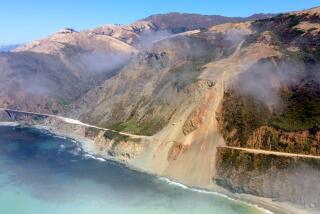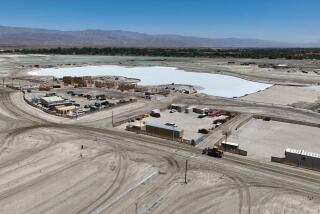Highway Is Sedonaâs Road to Ruin, Foes Say
PHOENIX â The saguaro and sage brush-covered desert along Arizona Highway 179 gives way to dramatic brick-colored cliffs and clusters of pinion junipers as drivers approach Sedona.
Tourists in rental cars inch along this narrow highway in northern Arizonaâs red rock country gazing at Mars-like formations while delivery trucks and 18-wheelers zip by.
The result is a potentially deadly meeting of nature and necessity.
Transportation officials, worried about safety and congestion caused by the 3 million visitors per year, want to expand Highway 179. But local leaders and environmental advocates argue the widened highway would damage the beauty of the area.
The two sides are brokering a compromise, but it remains a fragile one.
Sedonaâs red rock surroundings were listed as one of the nationâs 10 most threatened landscapes in 2001 by the conservation group Scenic America because of the Arizona Department of Transportationâs plans.
The Transportation Department wanted to widen about six miles of roadway that meanders through the Village of Oak Creek and Sedona to increase safety, make maintenance easier and speed up emergency response. The project called for two lanes going in each direction with a turn lane in the middle -- five lanes in all.
But residents and Sedona officials opposed the plan, saying the measures were drastic and would damage the majestic landscape, while negatively affecting tourism and their quality of life.
Sedona, 115 miles north of Phoenix, draws tourists and residents with its breathtaking beauty and solitude. But it also is a popular haven for artists and New Age pilgrims.
âThe scheme that would widen this road to five lanes would provide an automobile expressway, but there is no room for respect of the landscape and the multiple values that it has for human beings and other forms of life,â said Meg Maguire, president of Scenic America.
âIt would make this area like so many others -- accommodating the automobiles but not the human spirit and not the natural world.â
Transportation officials have come up with a less drastic approach to changing the road, which is used by 13,000 to 20,800 vehicles daily. âWeâve moved from conflict to cooperation, and that is a much better world to live in,â said spokesman Doug Nintzel.
The department has been meeting with officials from the city, Coconino National Forest, and Yavapai and Coconino counties since last summer.
They have agreed to consider a five-year plan that includes a section-by-section evaluation of the roadway along a nine-mile strip of the highway between Sedona and Interstate 17, part of which travels through the Coconino National Forest. Construction is slated to begin in 2005.
Officials will work on the congested intersection of 179 and 89A in Sedona beginning in the summer of 2006.
A group of Sedona residents formed the Voice of Choice about two years ago because of the transportation departmentâs initial plans. Members are pleased that officials are considering a less invasive approach.
âWeâre proceeding on the basis that they are operating in good faith, and as long as they are, we will,â said Sedona Mayor Dick Ellis and former Voice of Choice president.
But the group remains worried about the departmentâs desire to buy more land than it needs at the moment.
Gail Shaw, a Voice of Choice member, said if the department buys land that might be used to widen the roadway to five lanes in the future, it will be a âdeal-breaker.â
The departmentâs deputy director, Debra Brisk, said it wants to buy land to plan for the future.
âWe still need to think about how things will be 20 years from now,â she said. âIt is a scenic corridor and we are going to respect that.â
The debate about how to make road improvements without devastating the beauty of the area isnât new and isnât expected to go away soon.
Sedona officials approached the department 11 years ago about repairing the road and building turn lanes and shoulders, but repairs werenât considered until about two years ago.
When the department finally explained its planned changes, opposition formed. âThatâs when the public rose up,â Shaw said.
Transportation officials estimate that usage will grow to about 36,000 vehicles per day on certain sections of the road by 2025. But city officials donât expect traffic to increase that much because Sedona, surrounded by U.S. Forest Service land, can only grow about 20% larger.
The groups are working together, but they still have a long road of compromise ahead.
âThe citizens in the area need to continue to be very vigilant over this project and to make sure Arizonaâs DOT does not destroy the setting of this road,â Maguire said.
âThey should question all the details and look at all the fine print.â
More to Read
Sign up for Essential California
The most important California stories and recommendations in your inbox every morning.
You may occasionally receive promotional content from the Los Angeles Times.










